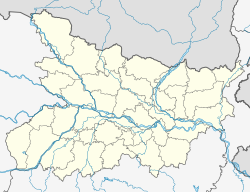This article includes a list of general references, but it lacks sufficient corresponding inline citations .(June 2019) |
| Rajnagar Palace | |
|---|---|
 A Durga temple in the Navlakha palace campus | |
| Type | Palace |
| Location | Rajnagar, Bihar, India |
| Coordinates | 26°24′11″N86°10′13″E / 26.40306°N 86.17028°E |
| Area | 1,500 acres (610 ha) |
| Founder | Darbhanga Raj |
| Built | 19th-century |
| Demolished | 15 January 1934 |
| Architectural style(s) | Mithila Art |
| Owner | Darbhanga Maharaja |
Location in Bihar | |
Navlakha Palace, also known as Rajnagar Palace, is a royal palace in the town of Rajnagar, near Madhubani in Bihar, India. The palace was built by Maithali Brahmin Maharaja Rameshwar Singh of Darbhanga.


